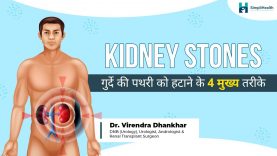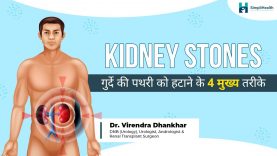Dr. Virendra Dhankhar
Dr. Virendra Dhankhar
Kidney Stone Treatment
Dr. Virendra Dhankhar, a senior consultant urologist andrologist and transplant surgeon in Chandigarh. Happy Diwali, everyone. Today we will be talking about the various operations for kidney stone treatment.
Kidney stone is a very common problem in North India. Sometimes the stone moves in the uterus, then the bladder, and is passed out of the body with urine. On the other hand, few of them stay in the kidney. A 5-6 mm stone has a 70-80% chance of being passed out of the body. And therefore, they are usually not treated. A certain profession requires the person to be stone-free, like a merchant navy, military, or a pilot, hence due to professional hazards. The 5-6mm stone is removed.
If the stone is big, then it is necessary to remove it with an operation. But if this stone is not removed, it may cause some serious problems like it will grow in size, cause infection, and bleeding, and may damage the kidney.
What are the kidney stone removal operations?
There are four operations performed to treat kidney stones.
- Extracorporeal Shock Wave Lithotripsy (ESWL)
- RIRS
- PCNL and its types
- Open surgery
Open surgery is not used in these times. I do not remember a time that I have performed open surgery on any patient. So, according to me, open surgery is not required in today’s time.
So we would be focusing on the three main surgeries, i.e., RIRS, PCNL, and ESWL.
Diagnosis for kidney stone treatment
Now we will discuss the investigation we do when the patient comes to us with a kidney stone. The majority of the patients come with their ultrasound results. If not, then we suggest an ultrasound test or a CT scan. This helps us know the size, and location of the stone, whether it is in the right or left kidney, and in which part, etc.
After this, an IVP or CT IVP is done. This helps us know the functioning and the roadmap of the patient’s kidney. The location of the stone, the functioning of the kidney, and swelling in the kidney are all determined by this test.
The advantage of getting a CT is that along with the functioning, it also tells us the density of the kidney, which we determine by the Hounsfield units (HU). This helps us map a perfect treatment plan.
Treatment for Kidney Stone
To decide the treatment of the kidney stone, we take into consideration the following factor:
- Stone factor
- Patient factor
- The location of the patient
What do we see in the stone factor?
Number one, the Size of the stone; how big the stone is. Number two, the location of the stone; where it is located. And the third factor is the hardness of the stones.
Then the treatment is done accordingly.
Stone factor
The kidney has different parts, upper calyx, middle calyx, lower calyx, pelvis, and then a junction pipe called the ureter. The lower calyx is a dependent portion, so it is difficult for the stone to pass on its own. Therefore, if the stone is located in the upper or middle calyx or the pelvic, it is considered to be a favorable stone. And the stone located in the lower calyx is considered the unfavorable stone.
If the stone is in the lower calyx, then the stone’s angle and hardness or density are determined. If the stone is hard, then it can’t be broken by a Lithotripsy. Below 800 Hu can be broken easily. But 1200 Hu and above are very hard stones and can’t be broken by a Lithotripsy. Between 800-1200 is the borderline stone, which helps determine a proper treatment option.
So this is the stone fact: location, size, and density. If the size of the stone is less than 2cm, then it can be treated with Lithotripsy, PCNL, or RIRS. If the stone is 2.5-3 cm, then PCNL is the best option.
Patient Factor
The second is the patient factor. What is the age of the patient?
If the patient is a child, then he must be given anesthesia multiple times. So then, the treatment should be chosen accordingly.
If the patient is obese, then the rays in the Lithotripsy don’t work efficiently. The third thing to consider is if the patient has a heart condition and is taking blood thinners that cannot be put on pause. We have to keep in mind all these things while selecting the correct treatment for the patient.
Location of the patient
How far does the patient live from the hospital? If there is an emergency, will he arrive on time at the hospital? If the patient lives far from the hospital, then he won’t be able to come to the hospital for his Lithotripsy sessions. So then, this option would be ruled out for him.
So we must take into consideration all of these factors before choosing a suitable treatment method.















Comments (0)